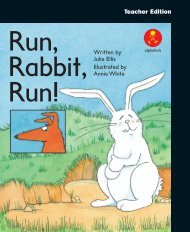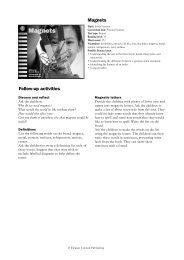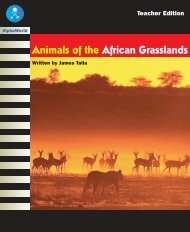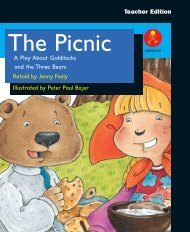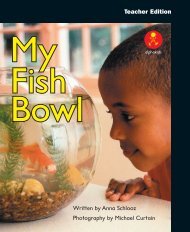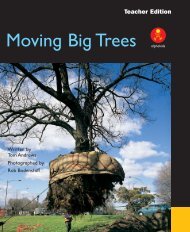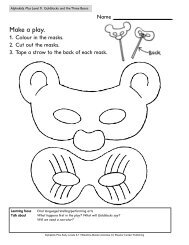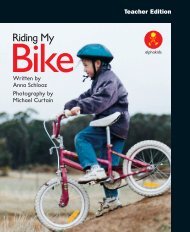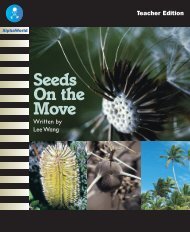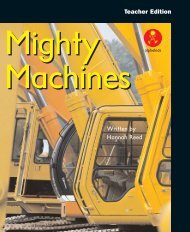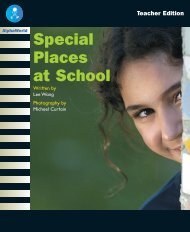GORILLAS
GORILLAS
GORILLAS
- No tags were found...
You also want an ePaper? Increase the reach of your titles
YUMPU automatically turns print PDFs into web optimized ePapers that Google loves.
Teacher Editionalphakids<strong>GORILLAS</strong>WRITTEN BYTILLY COLLINSPHOTOGRAPHY BYMICHAEL CURTAIN
Published edition© Eleanor CurtainPublishing 2004First published 2004Apart from any fair dealing forthe purposes of study, research,criticism or review, aspermitted under the CopyrightAct of Australia, no part of thisbook may be reproduced byany process, or transmitted inany form, without permissionof the copyright owner. Wherecopies of part or the whole ofthis book are made under PartVB of the Copyright Act, thelaw requires that records ofsuch copying be kept and thecopyright owner is entitled toclaim payment.Developed byEleanor Curtain PublishingText: Nicole Di MarcoConsultant: Susan HillDesigned byAlexander StittProduction byPublishing SolutionsPrinted in ChinaISBN 0 7253 3417 71 2 3 4 5 6 7 8 904 05 06?How to use this bookBefore reading: TalkthroughTalk through the book with the children. Encouragethem to predict the text from the cover and thepictures, and to think about the information theyprovide. Direct the children’s attention to aspects ofthe text that may challenge them. Support the childrento deal with these challenges by asking theTalkthrough questions on each page.During reading: Observe and supportObserve the children as they read. Encourage them tomonitor their own reading as they comprehend thetext. As needed, support the children by helping themto discover and use reading strategies and cues to solveproblems and respond to reading challenges that arisein the text. Interruptions to the children’s readingshould be minimal and focused on specified learningneeds.After reading: Comprehension, returning tothe text, responding and writing linksTo further develop children’s understanding of thetext, select from activities found on page 16 and theinside back cover. These whole text, sentence and wordlevel activities reinforce the teaching focus of thisbook. Assessment ideas are provided to assist withplanning for further teaching.Text highlights• The text compares and contrasts the livesof gorillas in the wild with those of gorillasin a zoo.• Colour photographs support and extendthe text.Vocabularydens, family groups, forests, gorillas, keepers,leader, live, shelter, zoo
Setting the contextPrepare a chart like the one below.Gorillas in the forestGorillas at the zooIntroducing the bookThis is a book about how gorillas live. Somelive in the wild and some live in zoos.Ask the children to think about how gorillasmight live in the forest and how they live ina zoo. Write the children’s ideas on thechart.Front coverWhat do you notice about this gorilla? Whydo you think the publishers put it on thefront cover? Does it make you want to readthe book? Why?Title pageRead the title together.Point out the names of the author and thephotographer.
Gorillas Pages 2–3?TalkthroughSome gorillas live in forests. What do you think might behappening to many forests? How would this affect gorillas?Observe and supportDo the children check what they read with the phonicinformation on the page?Point out a word, for example ‘alive’, and ask thefollowing questions.How did you know what that word was? What did you check atthe start of the word? What did you look for at the end of theword? What else did you check?2
Gorillas Pages 4–5?TalkthroughSome gorillas live at the zoo. How would a zoo look aftergorillas and keep them safe?Observe and supportDo the children use contextual information tounderstand the meaning of new vocabulary?What does ‘shelter’ mean? How did you work that out?4
Gorillas Pages 6–7?TalkthroughHow do gorillas live in the forest? What is a family group? Dogorillas live in family groups at the zoo?Look at the big male gorilla on page 7. He is the leader of thegorilla group. The biggest male is always the leader.Observe and supportDo the children monitor their own reading?What did you notice? Why did you read that again? How do youknow you are right this time?6
Gorillas Pages 8–9?TalkthroughWhere do gorillas sleep in the forest? What do they make nestswith?Where do gorillas sleep at the zoo? What do they make nestswith?Observe and supportCan the children read the text fluently?Model reading a passage of the text to the children,then ask them to read it with you.Can you make it sound like I do?Have the children read the text by themselves.8
Gorillas Pages 10–11?TalkthroughGorillas spend most of their time in the forest looking for foodand eating.What does a zoo keeper do? What are the keepers in thephotograph doing?Observe and supportCan the children understand the inferences in the text?Would it take a long time to find food in the forest? What didyou think about to decide on your answer?10
Gorillas Pages 12–13?TalkthroughDo you think gorillas eat the same things in the forest as theydo at the zoo? Why or why not? Read page 12 and see if yourprediction was right. What do gorillas eat?Observe and supportDo the children search for a range of information onthe page to support their reading?When you looked at the pictures before you read the writing,what were you looking for? How did that help you?12
Gorillas Pages 14–15?TalkthroughWho looks after the baby gorillas in the forest? Who looks afterthem at the zoo?Observe and supportCan the children recall information supplied in thetext to support their point of view?Where do you think it would be best for gorillas to live? Why?14
Gorillas Page 16? TalkthroughWould a zoo be a safe place for a gorilla to live?What does the author think?After readingBeing a meaning makerEncourage the children to support their responseswith evidence from the book as they discuss thesecomprehension questions:What do gorillas eat in the wild? What do they eat in zoos?Why do the keepers prepare the gorillas’ food in the zoo?Where is the best place for gorillas to live? Why do you think this?16
Being a code breakerExplore the following language features:• High-frequency words: also, and, are,at, after, by, for, have, in, make,many, of, or, some, the, their them,they, to, too, with.• Hearing sounds: read sections of thetext and ask the children to listen forwords that contain the sound /oo/;for example, zoo, food, too.Being a text userRefer to the text and the chart made inthe ‘Setting the context’ section whendiscussing these questions:What kind of book is this? How do you know?What information on our chart does the booksupport?What new information have we learned fromreading this book?Being a text criticWhat is the author’s point of view about wheregorillas should live?Do you agree with her point of view?What other points of view are there?Responding to textThe children could work incooperative groups to make amodel of a good place for gorillas to live.You could provide play dough, plantcuttings, paper and other art materials.Ask the children to write sentencesbased on the chart made earlier.For example, ‘In the forest gorillas sleepon the ground’; ‘At the zoo gorillas sleepin dens’.Ask the children to fill in a tablelike the one below with thesingular and plural forms of nouns fromthe text.If I have one, I say:gorillaIf I have more thanone, I say:gorillasWritingThe children could write an argumentstating where they think gorillas shouldlive and why. The children’s views couldthen be shared, and compared andcontrasted.AssessmentCan the children:• compare and contrast information?• summarise the information they have learned about gorillas?whole text activity sentence activity word activity
ALPHAKIDS<strong>GORILLAS</strong>WRITTEN BYTILLY COLLINSPHOTOGRAPHY BYMICHAEL CURTAINTeacherEditionOtherbooksat thislevelalphakidsCircus BoyWritten by Mary-Anne CreasyPhotography by Michael CurtainTopic: GorillasCurriculum link: ScienceText type: ReportReading level: 11Word count: 189High-frequency words: after, also, and, are, at, by,for, have, in, make, many, of, or, some, the, theirthem, they, to, too, withVocabulary: dens, family groups, forests, gorillas,keepers, leader, live, shelter, zooPossible literacy focusComparing and contrasting two groups.Summarising information in a book.BillyBananaWritten byJack HastingsIllustrated byChantal StewartFlyingMachinesWritten by Mary-Anne CreasyalphakidsalphakidsThe Baby Picnic BearA Play About Goldilocksand the Three BearsGoes for a WalkRetold by Jenny FeelyIllustrated by Peter Paul BajeralphakidsSummaryThis book compares and contrasts the lives ofgorillas in the wild with those of gorillas in a zoo.ISBN 0- 7253- 3417- 79 780725 334178alphakids



